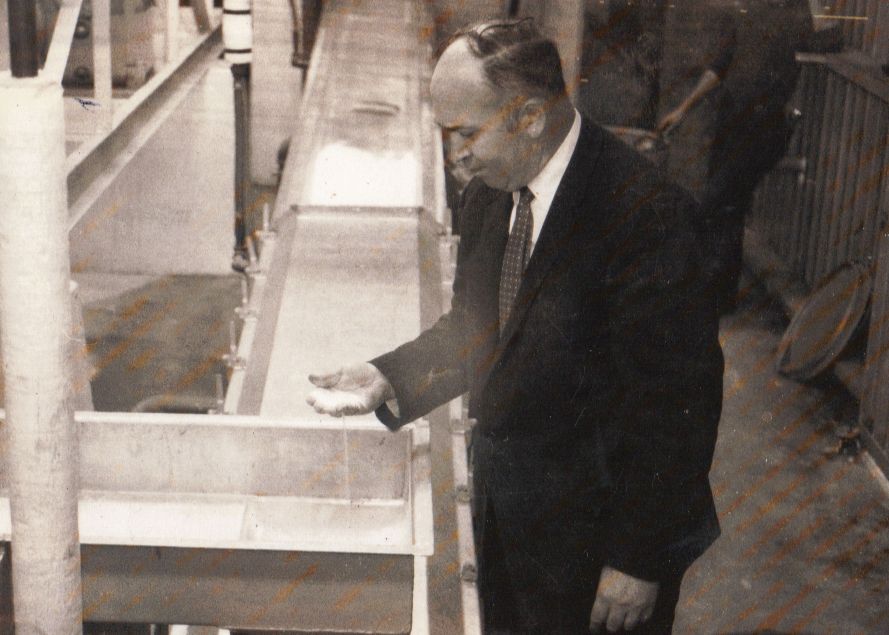 He accepted an offer as Vice President and Director of Research and Development at Bzura, Inc. in Keyport, NJ. Robert worked with Bzura from 1955 – 1964. He began work here on producing Citric Acid from Black Strap Molasses. He traveled often to Cuba because he was working to find a way to produce black strap from sugar cane, which was in plentiful supply there. His work at Bzura culminated in the building of a four million dollar plant for the manufacture of citric acid based upon a process developed by this research group.
He accepted an offer as Vice President and Director of Research and Development at Bzura, Inc. in Keyport, NJ. Robert worked with Bzura from 1955 – 1964. He began work here on producing Citric Acid from Black Strap Molasses. He traveled often to Cuba because he was working to find a way to produce black strap from sugar cane, which was in plentiful supply there. His work at Bzura culminated in the building of a four million dollar plant for the manufacture of citric acid based upon a process developed by this research group.
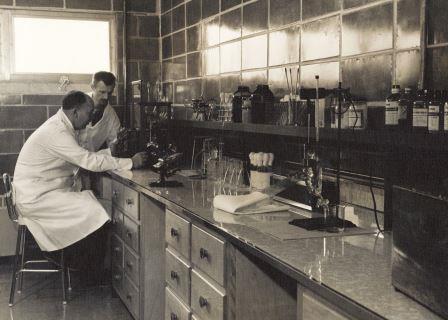 Bob, the teacher-parent again, brought his kids to work to see the lab he was justifuably proud of. Greg remembers seeing the large vats of black-strap molasses that were used as a basis for making the citric acid. Carolyn remembers the rows of petri dishes that were growing the mold that was involved in the process.
Bob, the teacher-parent again, brought his kids to work to see the lab he was justifuably proud of. Greg remembers seeing the large vats of black-strap molasses that were used as a basis for making the citric acid. Carolyn remembers the rows of petri dishes that were growing the mold that was involved in the process.
This work would have repercussions in the form of a lawsuit against the company, many years later. Sue recalled that a lawyer was sent for a deposition from Bob when he was in his 80s, living in coastal North Carolina (circa year 2005). Bob knew that Bzura was burying 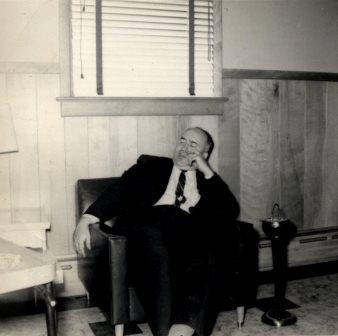 barrels full of toxic chemicals, but maintained he had absolutely nothing to do with it. He was working with a part of the company that engaged in research and development. Probably, however, he was one of the few employees from that era at Bzura, who were still alive. When I visited him shortly before this time, I remember him being quite nervous about the lawyer coming and feared that he didn’t remember those times that were more than 40 years previous. At any rate, in the end, Bob was cleared of any wrongdoing.
barrels full of toxic chemicals, but maintained he had absolutely nothing to do with it. He was working with a part of the company that engaged in research and development. Probably, however, he was one of the few employees from that era at Bzura, who were still alive. When I visited him shortly before this time, I remember him being quite nervous about the lawyer coming and feared that he didn’t remember those times that were more than 40 years previous. At any rate, in the end, Bob was cleared of any wrongdoing.
According to a 2018 article by David Matthau and Sergio Bichao, “The Garden State might as well be called the Toxic Waste State. New Jersey has 114 Superfund sites — more than any other state in the nation.”
Read More: Polluted New Jersey: The most toxic sites in your neighborhood
Rabi verified this information from the National Priorities List on the EPA website.
One of Bob’s oft-quoted Bible verses was “it is easier for a camel to go through the eye of a needle than for a rich man to enter the kingdom of God”. His take on it was, It’s easy to be a rich man in this world — If you look the other way and give up your values.” He truly believed in integrity and doing the “right” thing.”
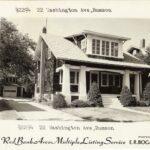 Robert and Priscilla bought a wood frame home near the Jersey shore, 22 Washington Avenue, in the West Park area of Rumson, Monmouth County, NJ on 10 December 1956, from a single gal, Marie Park Eichler. Built in 1927. It’s a 4-bedroom, 2-bathroom, 1,740.00 sq. ft. home.
Robert and Priscilla bought a wood frame home near the Jersey shore, 22 Washington Avenue, in the West Park area of Rumson, Monmouth County, NJ on 10 December 1956, from a single gal, Marie Park Eichler. Built in 1927. It’s a 4-bedroom, 2-bathroom, 1,740.00 sq. ft. home.
The Redfin estimate for this home in 2021 was $931, 333.00 and said further: “CHARM ABOUNDS IN THIS SHORE COLONIAL. WONDERFUL FRONT PORCH TO SIT & WATCH YOUR CHILDREN PLAY IN THIS FAMILY ORIENTED NEIGHBORHOOD. GREAT SCHOOLS.”
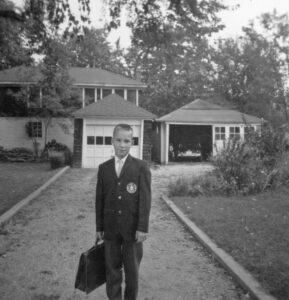
There was a detached garage at the far back of the property. Marie and Greg remember picking all the weeds out of the gravel driveway. There was never a weed left there!
There was a large old Magnolia tree in the back yard that provided hours of fun for the children climbing. I remember creating floor plans for homes by raking the Magnolia leaves into shapes of rooms, etc.
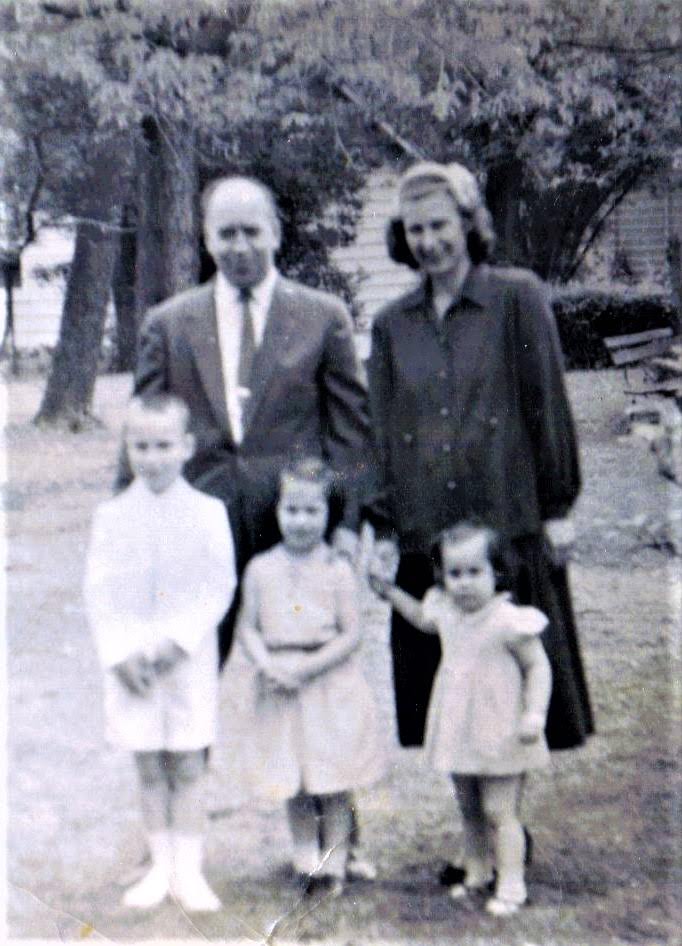
Bob put in a fence between the Kieber’s yard and the Fishes, who lived on the side. He also began grafting roses: Bob had planted roses along the side fence in the backyard. He would graft a cutting of one rose onto a sturdy rootstock of another and create new plants. Marie remembered how he used a bag over the grafted cutting. Another way he created new plants and taught to Marie was: stick the cutting in a powder, such as rootone or fungicide, put it in dirt, water it, and covered it with a mason jar also to make new plants.
There was a small den on the first floor. The black and white TV set was in there. The kids would sit on the floor to watch it. There was a small couch beneath the window overlooking the side yard. Carolyn remembers the Venus Fly Trap on the windowsill and feeding it hamburger. Ever the teacher, Bob would use these hobbies as teaching tools for his children. In this case, about the fly trap’s carnivorous appetite. Bob’s love for plants was passed on to his children, most of whom are or have been active gardeners.
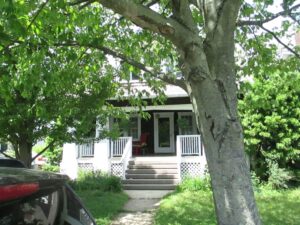
About Rumson: The Historic Preservation Commission for Rumson says this about the history of this beautiful and olden town: “Historic Rumson was settled in 1665, as a result of a land purchase from native Americans. The Lenni-Lenapé, a tribe within the larger tribe of the Delawares, lived on the Peninsula and named it Navarumsunk. Throughout the years that name was shortened and changed to Rumson. Rumson was officially incorporated as a Borough in 1907.”
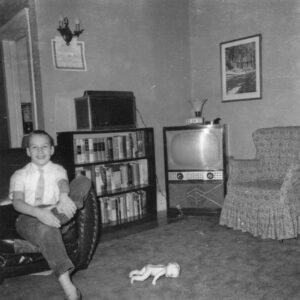
The front door opened directly to the living room. There was also a couch here, this time beneath the from windows. That’s where the children stayed when they were sick with one of the childhood diseases like chicken pox or mumps.
Bob began a new hobby at this time: raising tropical fish in a couple of aquariums. He built a wooden display case that was kept in the living room. The glass tanks soon became home to neon tetras, kissing gouramis, angelfish, black mollies, guppies, and of course, his kids remember the swordfish who had babies, and would eat their babies if you did not put them in a separate cage. Years later, David and Devin would take up the hobby. There was also a lovely stone fireplace with a mantel, though not sure there was ever a fire built in there.
The dining room opened to the side of the living room and had a doorway to the kitchen in the back. The Kiebers had the large walnut dining set from Bob’s mother. The Kieber-Emmonses enjoyed that table for many years after Bob and Pris retired. Today, the Grady family in Albuquerque has that set.

The home had a full basement. Stairs led down from a small hall behind the kitchen to a door outside and then a landing and then down into the basement. As you entered the main room of the basement, which was dark and creepy by many accounts, Robert had his tools, including a large, floor-standing drill press and a tool bench.Across from the stairwell, Robert rigged up a dark room. He had long been interested in photography and took many photos of his beautiful wife, some of which he developed himself. Today, Greg and Dave pursue the hobby quite seriously, and Devin has had a darkroom, experimenting with many different methods of printing for years. His work has been in many juried art shows.
The stairs up were in the living rooom. Upstairs, there was a bathroom, walk-in closet, and a bedroom to the right. three more bedrooms were to the left, including the master, which opened onto the aforementioned, sunroom. Children were not allowed in their parents’ bedroom. Since the children only bathed every Saturday night (which was fairly commonplace, at the time), the one full bathroom was not a problem.
The bedrooms soon became quite crowded. Carolyn and Barbara slept on bunk beds in the room across from their parents’. When Bobby was born, he slept in a crib in their room as well. The girls switched off who would sleep on the top bunk — or perhaps Robert made Carolyn move up there because when she was assigned to the lower bed, she had so annoyed Barb by kicking the upper bed from underneath! Once on the upper bunk, Carolyn had many nightmares of the bridge (see below) and of the world ending (perhaps due to reading the Apocalypse or the Cuban Missile crises which affected her for many years). Yes, some of the children had very active imaginations!
When they bought the home in 1956, Bob and Pris had 3 children. But the family quickly grew and the house filled with five additional children, born in 1956, 1957, 1959, 1960, and 1961. When Pris was gone to the hospital to Bob would make, what he called, tuna fish al la casa in a blender for the children’s dinner. The very mention of tuna fish al la casa among Bob’s children evoke vivid memories where the word delicious is NEVER used. For the next baby, Bob hired Mrs. Connie Habercaust to stay with the children and cook, etc. As the family grew, and Priscilla was pregnant most years, the older children had to take care of the younger siblings. Carolyn, who was 8 or 9 years old, remembers sleeping in the den with a baby in a crib there. In the middle of the night when the baby woke, she had to get up and make a bottle, and warm it in hot water on the gas stove. Then feed the infant. She had no problem with that, but she was very afraid of sleeping alone on the first floor, since the bedrooms were all upstairs. But there was no way Robert was going to let her get out of her job. Priscilla and he needed rest!
When Robert was 36 years old, his father John, died in Christian Brother’s Nursing Home from a cerebral hemorrage and arteriosclerosis on 10 April 1956. A very sad story Robert told just before he died, was that his father, when lying on his deathbed, told Bob, “You never loved me.” It was a shock to Bob, who had had no idea that his father thought that about him. Perhaps his Dad felt that way because Bob had moved far away from the family center in Buffalo. Maybe he had felt judged when Bob furthered his education. We’ll never know the answer, but the situation was obviously very painful to Bob. And, on his deathbed, he was certain to tell each of his children how proud he was of them and how much he loved them.
Keeping with his German heritage, all of the children had chores. Robert felt this was important for feelings of self-worth and belonging in the family. Chores also taught the children useful life skills for caring for smaller children and caring for the home. Bobby’s first memory is of Robert telling him to “paint” the back stairs with a old paint can filled with soapy water. He was not even five years old! Carolyn remembers washing the windows in the beautiful second floor sunroom and the many paned glass doors that led to it. She used newspaper and vinegar and tried and tried to get rid of the streaks. Marie remembered dusting the dining room table and chairs.
In addition to the household chores, Greg had a large paper route. It covered the “Point” as well as Avenue of Two Rivers. Carolyn remembers helping him on occasion deliver the papers in the afternoons. Later, all of the children would have jobs outside the home when they turned sixteen, if not before then.
Two blocks west along Washington Avenue, was Polly’s Pond, where Bob’s kids spent many happy days crabbing or fishing. In 2021, the pond was dredged to connect it to the river, and then to the ocean. Now known as Oyster Bay, the area is totally developed with stately homes, docks, yachts, etc. Two blocks east was the beautiful stone, St. George’s Episcopalian Church on the Shrewsbury River where Marie and Carolyn took ballet lessons. Though Bob said that the girls complained bitterly about going to dance class, Marie remembered enjoying it; Carolyn loved her emerald green leotard. They both wondered years later why they did not continue. — And, together, the two sisters did take a modern dance class in Ann Arbor many years later.
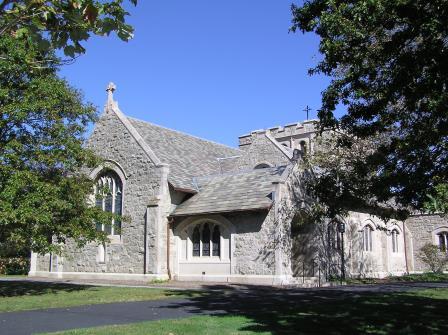
The land the house was situated on, formed a small peninsula between the two bodies of water: the Shrewsbury River and Polly’s Pond. There was another small pond on “the Point” that was shallow and the children ice skated in winter. Carolyn particularly enjoyed skating and did so until her ankles ached!
Situated as it was between the two bodies of water, there were many floods. Bob’s kids remember townsfolk coming out to Holy Cross and rowing them home in their rowboats one day. Most likely it was the Storm of 1962, sometimes called the Ash Wednesday storm. It was a deadly, some say “freak” Nor’easter. It was a three day storm that arrived with the spring king tides, causing major flooding. President Kennedy called for the military to help out the battered New Jerseyans. The storm was worse than Hurricanes Hazel, Carol and Agnes, that had all hit the area– and probably also caused flooding on low-lying Washington Ave.
Article From Red Bank Register 11 Oct 1956 Rumson Scouts Head Chemist
RUMSON— Robert Kieber of Rumson, head chemist at Bzura, Inc., Keyport, addressed members of Boy Scout troop 11 Monday night in Bingham hall. Mr. Kieber’s talk was the result of a request by scouts who had asked that men from different branches of industry and the professions be invited to speak to them during the year and to point out what courses in school will help them to progress in the fields open to graduates.
Mr. Kieber outlined a suggested program to follow beginning in high school for any boy interested in chemistry. He also pointed out the “unlimited opportunities” available In the field. William D. Salladln, Scoutmaster the past two years, issued an invitation to fathers of scouts to volunteer their assistance to the troop. Working with boys, said Mr. Salladln, is an “interesting experlence.” He added “One evening a month from each father would be of tremendous value in helping this troop to continue to grow.” Boys of scouting age recently moved into the borough have been invited to go to Bingham hall Monday at 7:30 p. m. and visit the troop prior to joining. The troop is planning to hold a candy sale similar to one held last year, featuring candy for Halloween.
The tradition continues.…Many years later, grandson, Nathaniel would address the Boy Scout troop of Great-grandsons, Milo and Cohen in Corpus Christi, TX and speak of his career as a scientist. Also, Michael invited Rebecca’s Brownie troop (which Carolyn led) to his laboratory at SUNY Fredonia and demonstrated many physics experiments.

Education was of paramount importance for Robert and Priscilla, perhaps because bob was the first in his family to not only complete college, but also to attain an advanced degree! Not only did he mentor young students in various clubs, but he and Priscilla ensured that the children made weekly visits to the library. And it worked — they all read for pleasure, several joining book clubs, into their adult years. The Oceanic Free Library on the corner of the Avenue of Two Rivers and Ridge Rd., Rumson became a Saturday ritual for the kids old enough to have a library card.
Coached Greg Pop Warner football one of the children –Marie — was a cheerleader had to be before HS 1964….so 1960—until then….1963 fall
greg was in little league and pony league home field was at rumson highschool… h
Junk Day was a highllight of the neighborhood. Community members would place their unwanted stuff at the curb. We kids would scour the piles neighbors left curbside for the garbage collector. But this was no ordinary garbage day; this was Junk Day! Folks left all sorts of large and small items they no longer had use for next to the street. I remember that we never bought a new toaster — we kids always found one in someone’s Junk Day pile! Today we’d say that was recycling 🙂 .
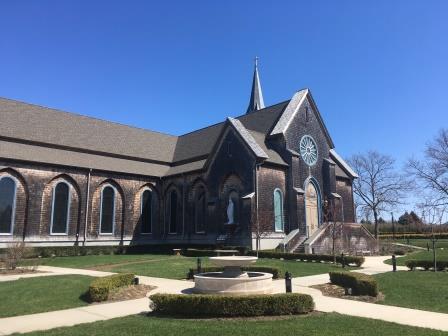
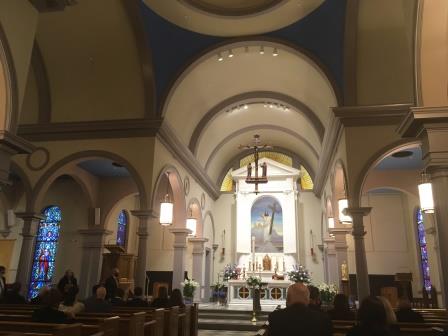
Bob felt strongly about his children receiving a Catholic education. As his children reached school age which was 5-years old, Kindergarten, at the time, he sent them to his Parish school, Holy Cross parish and elementary school, run by the Sisters of Mercy. The parish, as well as the school were established in 1929.
According to History of the Parish: “Between 1930 and 1955 several more classrooms were added to the school building, along with the south wing in 1937 and the north wing in 1947 that
contained additional classrooms on the second floor, an auditorium, kitchen and restroom facilities on the first floor, and a complete basement. Even more classrooms in the school and church basement followed. Enrollment continued to grow until it leveled off in 1961 at 1,230 students with twenty-one Holy Cross Sisters and ten lay teachers.” The pastor serving Holy Cross from 1947-1973 was Monsigneur Joseph A. Sullivan.
Eventually, his eldest, Greg became an altar boy, serving at many Masses there. One time, Fr. Sullivan refused reg communion. Greg never did find out why, but it was rather traumatic to the youngster.
IF you are interested in reading more about the parish, here is a link for an excellent history and a couple of photos: http://www.rumsonnj.gov/downloads/newsletters/2008-RBB-4.pdf of Holy Cross from a 2008 Bulletin. And a history of the pastors, including Msgr. Sullivan, can be found here
Still need to write up: cuban missile crisis 16 October – 28 October 1962. timed walking home….canned goods blankets…duck and cover
Coached Greg Pop Warner football one of the children –Marie — was a cheerleader had to be before HS 1964….so 1960—until then….1963 fall
greg was in little league and pony league home field was at rumson highschool… h
VICTORY PARK summer craft activities, dances, swimming.
After storms, if Bob heard that there was a sick or injured whale washed up on the beach at Sandy Hook or Sea Bright, he took his children to see it. Sometimes, the community organized to try to push them back into the ocean. Today, many whales are injured from boaters and wash ashore dead or injured. There are stories of burying the behemoths in the sand, but I don’t think we ever participated. At any rate, Cetation Stranding, as it is called, from a child’s point of view, was exciting, and very much awe-inspiring to see such large animals up close. Always though, tinged with a bit of sadness at the whale’s helplessness.
Because the ocean here is rife with Atlantic Menhaden, aka Bunker, a type of herring that Humpback whales consume. Today, Humpback sightings, in particular, are becoming more and more common. Scientists tell us that they stay for longer (30 – 40 days) and return for several years, ( NJ.com 2022) . Experts also say that higher ocean temperatures and better water quality is encouraging the behomoth comeback. There are even Whale watching tours available in the area now. And it’s not just Humpbacks that are seen, Fin and Minke are also common, as are Pygmy Sperm, Sperm and Northern Right whales less commonly seen. As late as 2021, a Pygmy Sperm Whale washed ashore at Sandy Hook Bay. In 2015, three Beluga whales spent some time in the Shrewsbury and Navesink Rivers, according to an article in CBS News New York online.
Because of the floods, as well as the fact that it was such a low-lying area, mosquito control was necessary. Tank trucks drove along Washington Avenue fog-spraying DDT. Priscilla would tell the children to quickly shut all the windows. But, what great fun for the older ones to run around in that fog! The neighborhood kids poured out of their homes (including me) and played, chasing the truck. Greg loved riding his bike behind the truck in the fog. Of course, today DDT is banned for the many adverse and toxic issues with its use. Here is an article from 2011 recounting a memory of running behind the trucks as a kid.
Because of the floods, as well as the fact that it was such a low-lying area, mosquito control was necessary. Tank trucks drove along Washington Avenue fog-spraying DDT. Priscilla would tell the children to quickly shut all the windows. But, what great fun for the older ones to run around in that fog! The neighborhood kids poured out of their homes (including me) and played, chasing the truck. Greg loved riding his bike behind the truck in the fog. Of course, today DDT is banned for the many adverse and toxic issues with its use.
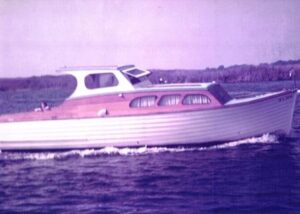 One of the highlights of living so close to the ocean was the possiblity of owning a boat. Bob ended up building a wooden 42′ cabin cruiser, which he christened the PRISCILLA.
One of the highlights of living so close to the ocean was the possiblity of owning a boat. Bob ended up building a wooden 42′ cabin cruiser, which he christened the PRISCILLA.
Tommy remembers Bob telling him about taking an airplane engine, (wanna say B-24) that he got surplus from an old friend and put a universal gear on it to change the torque, so basically the whole thing was free except for parts and labor. Bones thought the hull was salvaged for free, at any rate, Bob got it already built. The teak deck was the one big expenditure, as well as the twin aluminum moline gas tanks that he complained about because they cost so much to buy and fill. Then, Robert built the upper deck.
Bob and Steve Cook, a neighbor 2 doors down on Washington Avenue became good friends. I remember going over to the Cook’s home on a Saturday evening, when the adults gathered to watch the Lawrence Welk Show. The show featured, what became known a “champagne music” and it was certainly considered very old fashioned by us young folk. This was at a time when early Rock n’ Roll was sprouting on radio stations across the country. The Cooks became good family friends, the Kieber kids would show up at their house when Steve came home from work, and he would usually have some sort of sweet treat to share with them. I remember Mr. Cook showing us how to bake potatoes wrapped in tin foil in the Autumn leaf piles that we burned on the edge of the street. He called them “mickeys.”
Power Squadron and coast guard aux.in Rumson . Barbeque in Sandy Hook ….they would have a coast guard cutter…fort hancock at sandy hook Possibly Coast Guard Auxilliary in Rumson as well.
Robert belonged to the Shrewsbury Power Squadron, a boating club which began in 1935, with Rumson as the center and Twin Lights Lighthouse in Atalntic Highlands (highest point above sea level on the entire eastern U.S. seacoast).
He also joined the U. S. Coast Guard Auxilliary, Flotilla 2-2, serving Monmouth and Middlesex counties. The Auxilliary offered many boating courses that I’m sure Robert took so he would learn to skipper the Priscilla. The group also enjoyed family barbeques in Keyport and Clam Bakes at Sandy Hook. Many years later, Robert would be furious when Michael, Carolyn and Joe were out in the Navesink River, rowing a leaky rowboat, one of many that had washed ashore over the years, and the Marine Police cited them for having an unsafe vehicle, no life preservers,etc. The Auxilliary was all about safety on the waters! And, the tradition continues…many years later, Greg and Anne took a Coast Guard Auxilliary class on safe boating.
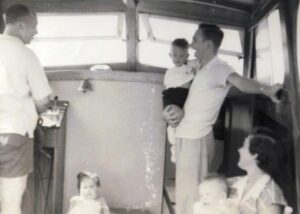 The boat was docked in summers in Keyport and drydocked in winter in the backyard. Mr. Cook, a dear friend and neighbor would work on the Priscilla along with the children who were old enough to learn how to scrape off the yearly accumulation of barnacles from the hull and redo the fiberglass parts of the boat. Marie remembered having fiberglass splinters in her fingers afterwards. And then there were so many fun fishing and Fourth of July fireworks trips out on the Atlantic. Bob really loved that boat.
The boat was docked in summers in Keyport and drydocked in winter in the backyard. Mr. Cook, a dear friend and neighbor would work on the Priscilla along with the children who were old enough to learn how to scrape off the yearly accumulation of barnacles from the hull and redo the fiberglass parts of the boat. Marie remembered having fiberglass splinters in her fingers afterwards. And then there were so many fun fishing and Fourth of July fireworks trips out on the Atlantic. Bob really loved that boat.
Here is an excerpt from Greg’s eulogy for his Dad (see RJK part 6), about the PRISCILLA:

Working as a “Bottom Man” on our boat, the SS Priscilla, taught me the value of hard work. For those who don’t know, a “bottom man” in our house was the person who prepared the bottom of the hull for the season, scraping barnacles and other debris, and then applying a coat of red paint — much of which got into my hair and clothes, possibly accounting for my pre-mature grey hair. Later, during the summer, as you and Mr. Cook enjoyed a Schaefer beer and cigar while floating out in Sandy Hook Bay fishing for flounder, I enjoyed the fruits of my labors while decling the “chum” sandwich you offered me.”
That day, Greg became seasick at the actual thought of a chum sandwich. Though, perhpas it was the cigars and Schaeffer beer Bob and Steve Cook used to enjoy while out on the water.
After they moved to Locust, the boat never made it back to the water, though Bob had bought all the wood for a dock. The pile of wood was left under the ancient copper beech tree and finally used for edging along the long gravel driveway. When he left Locust, Bob had to take an axe to the Priscilla because everyone wanted fiberglass boats at that time.
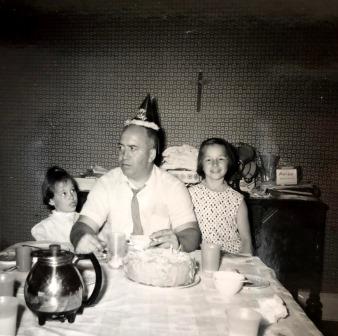
Bob was 39-years old when his mother, Anna died on 28 April 1959. Like her husband, John, Anna also succumbed to a stroke, we believe. Bob said that he and his brother, Lavern together, said the Catholic prayer for the dying for Anna. On 2 May, she was buried with John at Mount Cavalry Cemetery, Buffalo. Bob was 40 years old.
After Anna Ruhland Kieber died, some of the Kieber family belongings were sent to Bob in 5 foot high cardboard barrels. Bob’s family kept them while the children were growing and they went with the family to Locust as useful storage bins.This was before the use of plastic for everything. Imagine what to do without plastic bins for storage! At any rate, the Kiebers used the cardboard barrels for storing off-season clothing. Those barrels were always such a mystery to the kids who would find whatever fit from the hand-me-downs for the new season.
The growing family lived in Rumson for 9 years.
Leave a Reply